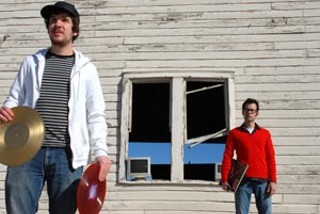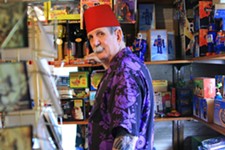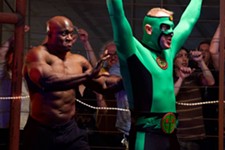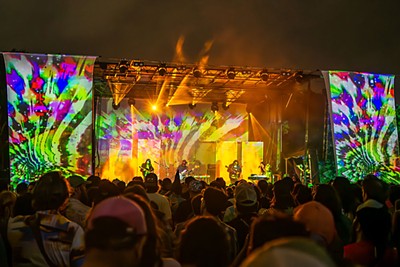Planet Funk Meets Planet Punk
Nu beats on famous bleats
By Marc Savlov, Fri., Jan. 12, 2007

Here's a neat trick for all you jaded, indie hipsters: Punch up YouTube, and check out Blondie's 1980 video for "Rapture." Pay special attention to Deborah Harry's snazzy rapping and the intoxicating subcultural smash 'n' grab of high art and low guitars, B-boy hipsters, and Basquiat hopheads of the There and Then.
When you're done, head over to the Here and Now: Austin's Beauty Bar, Mohawk, Whisky Bar, Plush, Gomi, FactoryPeople, or wherever local DJs like Chris Rose and Adreon Henry of Car Stereo (Wars), DJ Gates megaBradley and Ian Orth of Learning Secrets, Chris "Prince" Klassen, Cut Clubcutting Dave "Kidindie" Pacho, or DJ Mel are spinning hard-driven vinyl. Listen as the Doors' "Riders on the Storm" becomes "Rapture" becomes Simian's "Never Be Alone." Talk Girl Talk, make love to Death From Above like it's 1979, and spank rock. It's been bad.
Now close your eyes, and pretend you're Fab 5 Freddy, 'cause everybody's high. Today's Threat Level is DJ Red Alert, and the only thing worth watching on television is Television. The only party worth going to is Glen Friedman's TV Party. Don't stop. Do punk rock.
What's going on with the Austin DJ and club scene that, seemingly overnight, it's transformed into something akin to the Please Kill Me-era East Village NYC art-punk scene of three decades past? Reinvention, that's what.
Cultural echoes of the explosively artistic 1980s have been pinging about nationally at least since the turn of the millennium. Witness the return of skinny ties and tight jeans, radical political art and multimedia. Hear Franz Ferdinand and Bloc Party skittering across commercial radio, and sniff out reissues of edgy musical masterpieces from Richard Hell & the Voidoids, Television, and yes, even Blondie, to Britpunk godheads like Gang of Four, Wire, and the Buzzcocks. Wasn't that original prankster and erstwhile Sex Pistolero Malcolm McClaren popping up as producer of Richard Linklater's Fast Food Nation even as the Austin Museum of Art hosts their "Radical NY!" show, which features works by and of Richard Hell, Cindy Sherman, Keith Haring, and the spray-painted masterworks of the original Style Wars/Bleecker Street bombers? Planet Funk meets Planet Punk.
It isn't just James Brown and Joey Ramone who are dead, but the whole of L.A. style. Austin's rave scene, club music glitterati, whatever you choose to call it, barely made it to the year 2000. By that time the hypnotic beats of house music and its 10 million offshoots had become less hypnotic than metronomic, and what was once a vibrant and valid international music community devolved into factionalized genres and subgenres boasting overpaid jet-setters and so-called superstar DJs like trance master Paul Van Dyk and deep-house whipping boy Paul Oakenfold. Let's face it: They got stale, and clubgoers baled. The ecstasy led inexorably to agony: Last night a DJ bored me stiff.
That was all before Austin's trendsetting barroom triumvirate of Beautiful Mohican Whisky chasers ushered in this new, old sound that's equal parts mash-up tracks – new beats on famous bleats – indie rock guitar samples, and shiny new technology like Serato hijacked not only your average clubgoers expectations but also those who spin the vinyl. Finally, the only limit for DJs is the boundaries of their own imaginations.

"I refer to it as 'the New Shit,'" says Beauty Bar's Bart Butler.
He should know, too, having run Whisky Bar for the past five years while the only musical constant remained the evergreen hip-hop pop stylings of DJ Mel. Asked to describe Beauty Bar's musical milieu, "the New Shit" is as close as he can come to a fitting description of an overall Austin-centric musical mojo on the uptick.
"What's interesting about what's happening here at Beauty Bar," adds Butler, "is that all the bands know all the DJs and the filmmakers and photographers, and they've all pooled their talents into this one big scene. I think a lot of it has to do with MySpace and the fact that everyone's getting their party info off of everyone else's MySpace pages.
"That's been a huge thing for networking, for DJs, and for bands as well. The crowd here really pays attention to that. If it weren't for MySpace we wouldn't know about as many bands as we do alongside the Car Stereo (Wars) guys and Ian Orth's We Explode! and Learning Secrets parties. And somehow these differing styles are all fitting together and complementing each other.
"It's pretty remarkable."
Flashback to the last hours, minutes, seconds of 2006. At Beauty Bar, Car Stereo (Wars) pumps out a sonic barrage channeled into the champagne throng that packs the club's all-encompassing dance floor. Two guys, two turntables, one mixer, and one laptop are spinning emotional feedback loops of your favorite old-school dance staple retooled for a generation of permanent war footing: Prince's "1999" retooled by Chicks on Speed, a homemade do-over of Pulp's "Common People" that's even better than the original, ATX art-punk band Single Frame slamming into Miami's 2 Live Crew, and then, exactly at midnight, a stunning remix of – what else? – U2's "New Year's Day." From there, it just gets crazier, better, more Blondie.
Earlier, at Chris Rose's Super!Alright! HQ, which serves as both home to the film and video collective Super!Alright! and Car Stereo (Wars)'s day job/think tank, Rose explains that his partner Adreon Henry and he "combine hip-hop that we like with indie rock that we like and then force people to listen to it and love it."
Which is as good an explanation of mash-up culture as any other.

"Mash-ups get people interested in new music by mixing it up, via laptop software like Tractor, with older stuff they may already know," continues Rose. "I've done a half a dozen mash-ups so far. The first was 'Ghostface Observatory,' which combines Ghostface Killah's track 'Be Easy' with Ghostland Observatory's 'Midnight Voyage.' What's funny is that I did it as a joke when a friend of mine said I ought to try doing a mash-up. I did it in, like, 20 minutes. That worked out so well, I did another Ghostland Observatory mashed with Kelis' 'Bossy.'"
Don't get too comfortable, though. Car Stereo (Wars)'s impossibly fun live sets are about to change as live percussion, a notable but off-the-record female vocalist, and video projection/mixing enter the picture as Rose and Henry do mad prep work for their upcoming SXSW 07 showcase.
"Which is awesome, insane, and really, really weird," Rose says, "because we kind of applied as a joke. So that's our goal for March – go crazy with it and do as much as we can as far as taking it to the next level."
Suddenly, 21st-century music is all about mashing up the newest technology with cunning artificers via the Web and the thousands of music blogs (see sidebar) that allow anyone with an Internet connection instant and free access to virtually every sound ever recorded. Those tracks, many already remixed and mashed to within a nanobyte of their best beat, are then retooled by the likes of CS(W) and Dave "Kidindie" Pacho of Cut Club.
"I do some mash-ups sometimes," admits the 24-year-old ex-Houstonite over coffee at hipster nexus Jo's on Second Street, "but generally I play tracks that have been reproduced by others. Bands like the Yeah Yeah Yeahs have been remixed all over the place, so I add my own twist to that when I play a party by using the Serato Scratch Live mixing software [see sidebar]. And these days, every band wants a DJ to do this for them because they can be played at afterparties, which are getting to be bigger and more important than the concerts they follow.
"You're going to see that blow up at South by Southwest, too. Remixes by Soulwax and Kitsune out of Paris are so important right now. That's my goal this year, to play all my own tracks, my own remixes of other people's songs."
Another Cut Club DJ, Ian Orth, eschews too much technology, preferring instead the classic status of vinyl. ("I do a lot of remixes and mash-ups live, but I don't use Serato.") He's quick to agree that what's happening in this niche of Austin's reblossoming DJ culture is indeed a rebirth, the squalling, beat-driven bastard love child of long ago forebears (and onetime nemeses) disco music and punk rock.
"What's happening in Austin right now feels like the way people describe what happened in the punk rock movement back in the early Eighties," he ventures. "From 1977 to 1983 or '84 was an amazing time for both disco and punk rock, and there was a big crossover between the two styles for a while. That's happening again. Punk is becoming dancey, and dance music is getting rougher, more abrasive, more punk. And just like back then, kids are experimenting with art, drugs, fashion, music. It's an amazing time to be here.

"The punk rock kids and the hip-hop kids and the electronic kids are all coming together to party and have a good time, and that's what's so exciting about this city right now. It took a while to happen, but it definitely is happening. And the thing of it is, this isn't even anything all that new. This music has been going on for a really long time, but because it's now being mixed up and mashed up with dance beats and so on, it's perceived to be a whole new thing."
Think of it as an echo of an echo. Those Studio 54 beats and the glorious din of a thousand CBGB shows have merged and spit out a laptop offspring influencing an entire scene that, in Austin, revolves around Beauty Bar, Mohawk, Whisky Bar, and film and design outfits like Super!Alright! and at retail party/lifestyle hubs such as FactoryPeople and John and April Lohse's long-running and utterly unique Gomi, which also sponsors the monthly Paparazzi parties at Red River mainstay Plush. Speaking of which ...
"Our parties are pulling in a lot of the same crowd as Car Stereo (Wars) and Cut Club," notes Lohse, aka John Gomi, "but we're also seeing a lot of disenchanted former dance-music-scene people who've been looking for something different for a long time. Dance culture at the end of the Nineties got very straight and very white very quickly. It got very big-budget, too: You'd pay $30 for a ticket to see somebody who might or might not even show up. It lost a lot of its personality, and I think what we're seeing now has a real do-it-yourself feel to it. And while the mixing may not be particularly amazing, it's much more about hanging out, playing records, and getting your art on than it's about, 'Ohmigod, what a perfect mix!'"
John Gomi's been an integral part of Austin's DJ community since day one or thereabouts, so when asked to describe the changes he's seen taking place in the last decade, he knows whereof he speaks.
"The scene is funny now in that there's the indie hipster/scenesters on one end and then our Paparazzi parties, which pull in everyone from the weird vampire guys to the BMX kids to the entire waitstaff of Jo's. The music's funky and raw and weird, and whether you're at one of our parties or the Beauty Bar or Whisky or wherever, you never know what you'll hear next. I loved that last Prince album, and I'll push that up against some weird electro stuff, and it works just fine. It's a total art-punk vibe. It's like your life on shuffle. But Gomier.
"Have you seen that documentary Kill Your Idols?" he asks.
Of course. It's a history lesson about New York on the cusp of the Eighties, when Sonic Youth and Talking Heads were butting heads and street-fueled music and high art (and the even finer art of hanging out) all got together and had one hell of a party.
"That's the one," insists Gomi. "To my mind that's exactly what's going on in Austin right now. Music, art, clubs, design, punk ... it's all colliding all over again. And if you look at the sociopolitical landscape we have today – people are fucking disenchanted, man – it's beginning to look an awful lot like the bad old days. Which paradoxically makes for really good art, of all kinds.
"Back then it was guitars and feedback, now it's laptops and mash-ups. It's all pretty punk fucking rock to me." ![]()







